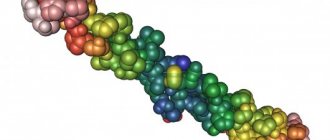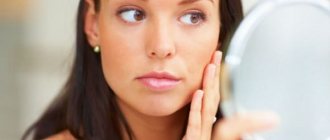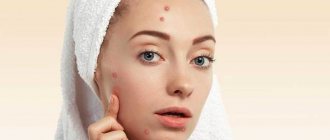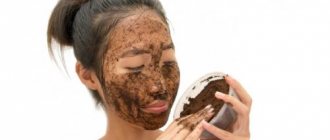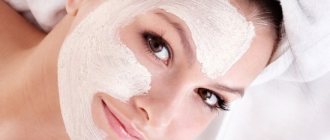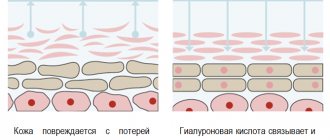What is skin atrophy
The pathology of the skin, which is characterized by deformation of structure-forming elastic fibers and, as a result, a decrease in the volume of the epithelial layer, is skin atrophy. It can be caused by both natural causes and pathogenic malfunctions in the body. The atrophic process can affect either only the fibers of the epidermis (including the basal layer), or spread to the deeper tissues of the dermis.
Observations by dermatologists indicate a predisposition to elastosis in women, due to their susceptibility to hormonal changes during pregnancy. White stripes, so-called striae, appearing after childbirth are also a type of atrophy. The disease is not inherited, but failures at the genetic level can lead to congenital pathology.
Symptoms
Signs of the onset of the process of atrophy of the epidermis in a patient are easily detected at an early stage due to a noticeable change in the appearance and condition of the skin. The main symptoms that are hard to miss are:
- accelerated death of the skin, expressed in the form of peeling;
- the appearance of small bluish or pink spots of oval or round shape (as in the photo);
- In rare cases, the affected area may hurt;
- the appearance of folding, wrinkling;
- There is a decrease in the sensitivity of the affected area.
The child has
The pathological process of atrophy in a child manifests itself more often on the surface of the skin of the extremities and neck. At the first stage, the painful area begins to be red and rough. After a few days, spots or streaks become noticeable. They can be either below healthy skin or rise above it, having a hernia-like appearance. If the disease occurs in childhood, there is a high chance of reversing the atrophic process if timely measures are taken.
The thin skin of the face turns red. Causes of facial redness
Red face: the causes and nature of the disease are completely clear today. Rosacea is a hereditary disease that affects people over thirty years of age who are fair-skinned. Women get sick more often after thirty years of age, which is apparently due to hormonal problems.
The cause of facial redness is the expansion of blood vessels located on the surface of the skin - with rosacea, this expansion is irreversible, the vessels no longer narrow, which may also be a consequence of improper functioning of the trigeminal nerve. Very often, rosacea occurs instantly, under the influence of one of the provoking factors, among which the most common are:
- - caffeine or alcohol abuse,
- - an excess of spicy and smoked foods in the diet,
- - prolonged exposure to the sun or solarium,
- - severe stress
- - hormonal therapy or hormonal diseases,
- - prolonged irritation from cold or high temperatures (very often, rosacea affects chefs and pastry chefs who are in production associated with the release of hot steam).
Red face: the causes are often associated with hormonal problems, neurosis-like conditions, gastrointestinal diseases or viral diseases.
As soon as the immune system drops and the hormonal system fails, under the influence of provoking factors, rosacea “blooms” in the literal sense of the word, causing enormous mental anguish, especially for women who have a hard time with a change in appearance. It is in order not to start the disease that it should be treated at the initial stage, when it is still possible to relieve the acute manifestation and keep the skin beautiful.
It is advisable to treat this disease in combination, under the supervision of a dermatologist, endocrinologist and often a neurologist.
Causes of thinning skin
In addition to the natural physiological causes of atrophy, aging and pregnancy, there are a number of established catalysts that cause pathological degeneration of the skin:
- neuroendocrine disorders;
- poor diet;
- previous diseases (lupus erythematosus, typhus, tuberculosis, syphilis, psoriasis, etc.);
- taking hormone-containing drugs;
- fungal infections of the epidermis.
Hormonal ointments
Atrophy can occur as a side effect as a result of treating a patient with drugs containing corticosteroids. Thinning of the skin occurs due to the negative effect of substances contained in hormonal ointments, which manifests itself in the form of suppression of the activity of collagen production. Changes in the structure of connective tissue fibers are a consequence of irrational therapy with the uncontrolled use of potent drugs.
Why is skin atrophy dangerous?
External manifestations of the pathogenic process of atrophy violate the aesthetics of appearance, the skin begins to look flabby, but this is not what causes the greatest concern among doctors. The danger lies in the development of malignant neoplasms against the background of diseases accompanying elastosis. Foci of idiopathic atrophy can contribute to the appearance of pathologies of a lymphoproliferative nature (lymphocytoma, lymphosarcoma).
Detection of compactions in the affected areas should be a signal to take emergency measures, since the formation of scleroderma-like and fibrous nodes is often a symptom of the initial stage of cancer. If you go to the clinic at an early stage of the development of pathogenic tumors, there is a possibility of stopping the growth of cancer cells.
Diseases that occur with skin atrophy
Atrophic manifestations of skin diseases may indicate pathogenic processes occurring in the body, the symptoms of which have not yet appeared. Diseases accompanying or preceding elastosis include:
- Schwenninger-buzzi anetoderma;
- scleroderma;
- anetoderma;
- diabetes;
- lichen sclerosus;
- Pasini-Pierini atrophoderma;
- pyoderma;
- cutaneous tuberculosis;
- encephalitis;
- Cushing's syndrome;
- developmental defect.
Treatment
The science of dermatovenerology, which studies the structure and function of the skin, currently does not have experimental evidence of the effectiveness of treating the atrophic process. Elastosis is irreversible, so doctors’ recommendations boil down to general health-improving preventive measures aimed at preventing the progression of the disease. Patients are prescribed penicillin, which supports a course of vitamin therapy and drugs that normalize cellular metabolism. In the case of a hormonal form of the disease, it is necessary to exclude the catalyzing factor.
External manifestations of atrophy can only be eliminated surgically, if the lesion has not spread to the lower layers of subcutaneous tissue. Oils based on plant extracts and emollient ointments have a supporting effect. Paraffin therapy and mud baths can be used for effective but temporary cosmetic camouflage of atrophied skin.
What materials to use for a mask for thin skin
When choosing facial products or using your own mask, the first thing you should look at is the composition. No need to take cosmetics from:
- flavorings
- strong fragrances
- preservative
- alcohol
- alkali
- acetylsalicylic acid
If possible, you should wash your face with thermal water. When persecuting and drying out, use bactericidal preparations containing zinc. Natural substances are best suited for masks: oil extracts, plants, milk.
Thin skin
Pathohistological changes in skin atrophy are manifested by thinning of the epidermis and dermis, a decrease in connective tissue elements (mainly elastic fibers) in the papillary and reticular layers of the dermis, dystrophic changes in the hair follicles, sweat and sebaceous glands.
Along with thinning of the skin, focal thickening may occur due to the proliferation of connective tissue (idiopathic progressive skin atrophy).
Atrophic processes in the skin may be associated with a decrease in metabolism during aging of the body (senile atrophy), with pathological processes caused by
- cachexia;
- avitaminosis;
- hormonal disorders;
- circulatory disorders;
- neurotrophic and inflammatory changes.
Skin atrophy is accompanied by a violation of its structure and functional state, which manifests itself in a decrease in the number and volume of certain structures and a weakening or cessation of their functions. The process may involve the epidermis, dermis or subcutaneous tissue in isolation, or all structures simultaneously (skin panatrophy).
In addition, thin skin can be a symptom of the following diseases:
Recipes at home
Indications and contraindications
You can determine that the skin is thin by two factors: it has a porcelain color and the same texture as the periorbital region, and it also reacts to the slightest irritant. In addition, masks can be used in the following cases:
- In the presence of wrinkles, swelling;
- If there are scars and scars;
- For problematic rashes and unhealthy complexion.
The use of masks is contraindicated if there is a high tendency to allergic reactions and severe inflammation.
Rejuvenating mask
This product is recommended for those who want to get rid of wrinkles and tighten their facial contours:
- Mix potato starch (30 g) with high-fat cream (15 g), let the mixture stand for 30 minutes;
- Add a couple of drops of vitamin E in an oil solution, put the composition in the refrigerator for 3 hours;
- Mix everything with chopped fresh parsley and mint, apply a uniform consistency to the epidermis and leave for 20 minutes, then wipe off with a napkin and wash.
Tonic
If the dermis has an unhealthy tint and reduced tone, you should use the following recipe:
- Squeeze the juice from a fresh cucumber, beat 50 cm with raw egg white, add an ampoule of tocopherol and retinol, as well as 10 ml of almond oil;
- Stir, add a little wheat flour and beat everything;
- We treat the skin, leave for 15-20 minutes and remove.
Whitening
This recipe is effective against scars and scars:
- Chop the parsley, mix it with 10 g of potato flour and 20 g of olive oil;
- Distribute the composition on the epidermis and leave for 20 minutes, after which we rinse.
Anti-inflammatory
To get rid of minor inflammations and pimples, just follow these instructions:
- Heat almond oil in a water bath, then wet your fingertips in it;
- Gently massage your face with light movements for 3 minutes;
- Wash everything off after 15 minutes.
Moisturizing
- Peel the avocado, remove the pit and puree the pulp;
- Combine 20 g of pulp with a small portion of olive oil;
- We treat the epidermis with the mixture, leave everything for no more than 20 minutes and go to wash.
We also advise you to read the article on Krasa-lady.ru Tightening masks.
To contents
Thin skin: what is the reason?
With age, the skin becomes so thin that with occasional minor impacts it becomes severely damaged and does not heal well. What to do to counter this?
We also recommend:
- Flabbiness, aging of the skin - Flabby skin is pale
- Dry, flaky skin - Dry skin is its most famous ailment.
- I'm lying in the sun. - I really want to take the pale one out
- How to choose a face cream - Choosing a face cream is not as easy as
- How to get rid of wrinkles - A very relevant question for anyone
- Dry hand skin is a problem familiar to many women - Very dry hand skin is a real thing
- Eye cream - The skin around the eyes is very graceful and
- Moisturizing creams dry out the skin - Many women have noticed the opposite effect
- Skin care: from youth to menopause - Skin aging is a natural process,
- Flip-flops and sandals are a dangerous type of footwear - Flip-flops and sandals lovers have an increased
A site for people who want to be healthy! 2009-2012 Health Portal as well as
Thin skin on legs. How to treat dry skin on the lower legs
Almost every person experiences dry skin on their legs sooner or later, especially after 35 years of age. The shins are the first to peel and itch, because the skin here is thin and fragile. It's time to think about cosmetic procedures and treatment of insufficient blood circulation in the lower extremities. Below help will help cure unpleasant dry feet.
Causes of dry skin on the lower legs
Some people believe that since the skin on the lower leg is dry and tight, just moisturize it and it will be as good as new. After wetting the skin, it really does become easier, but not for long. As soon as the water or oil dries, the skin peels off even more violently. And all because the real reason was not established, which is worth fighting. The list of such reasons is as follows:
- Poor nutrition. We are used to eating a lot of fried and fatty foods every day, which are not only useless for our body, but even harm it. To improve the condition of the skin on the legs, dermatologists recommend eating fish, fruit and vegetable desserts, salads, and soups. Lean on orange-colored products, they work well with dryness.
- Insufficient water consumption. Dehydration leads to the fact that the body spends fluid on basic life processes - sweating, digestion. To have enough water, every day you need
drink at least 1.5 liters of liquid. In summer, the volume of water is increased to 2 liters. - Lack of vitamins. Most vitamins and nutrients enter the body with food. And again we return to a healthy diet, it turns out that this is the basis of our health. Therefore, in the autumn, lean on citrus fruits. If you suffer from high acidity, brew aromatic linden tea, it also contains a lot of vitamin C.
- Today it is difficult to find a person who has never been sick. But this does not mean that chronic diseases need to be accumulated. If the attending doctor is unable to help you, another one will help; there are no hopeless situations.
- Incorrectly selected personal hygiene products. Antibacterial soap is used no more than a couple of times a day. The composition of such a product is too saturated with caustic substances; they literally eat up the surface layer of the dermis. Choose the right soap and shower gel; it’s good if they contain natural oils.
- The age of the person.
- Visit to the swimming pool, cleaned with chlorine.
- UV rays, including those from solariums, dry out the skin and can even lead to cancer.
- Tight-fitting clothing made from synthetic fibers leads to water imbalance.
Foot skin care rules
To bring the skin of the lower leg to a normal state, use the following advice from cosmetologists and dermatologists:
- Apply body moisturizer after showering. Then the nutritional components will be absorbed better.
- Replace alkaline soap with soft liquid soap containing natural oils.
- To improve blood circulation, direct a stream of water to your lower leg. This is a kind of foot hydromassage at home.
- If you are not sure about the effectiveness of creams, give preference to oils. Olive, almond, flaxseed are the best helpers for tight skin of the lower leg. Of course, there is no need to leave the oil composition for a long time. After 5 minutes, wipe off excess with a paper towel.
- Dry skin that bothers the lower legs is not the only blemish that can bother you. Dry shins are often accompanied by cracked heels. To remove the stratum corneum, pumice is used. It is better to leave the razor in the past, it greatly injures the dermis and contributes to infection.
- Ask a cosmetic store for effective body masks with a moisturizing effect.
Moisturizing masks made from natural ingredients
Eco-masks are gaining popularity every day. People are refusing to spend exorbitant amounts of money on dubious cosmetic products and are increasingly turning to natural moisturizing ingredients. A moisturizing mask for lower legs can be made using the following products:
- Mix cream or full-fat homemade sour cream with liquid vitamins A and E. Distribute the mixture on the skin and leave for 20 minutes. Then wipe off the mixture with a paper towel.
- Add a couple of drops of mint to 3-4 drops of lavender oil. Pour into a bottle of your favorite moisturizer. 2-3 applications of this mixture - and your skin will delight you with velvety and softness.
- Grind the apple into puree and add milk. Place the saucepan with the mixture on the fire and cook until the consistency of mush. Dry feet will thank you for such a wonderful moisturizing session! For greater efficiency, put a plastic bag and woolen socks on top. The mask is kept on your feet for 40 minutes, then washed off and lubricated with moisturizer.
- Measure out 4 teaspoons of baby cream, beat in 1 egg white, add 1 teaspoon of melted butter and add a couple of spoons of raw mashed potatoes. Mix the ingredients with a spoon and distribute on the lower extremities. The mask is worn for at least half an hour.
Thin skin
Skin atrophy occurs due to disruption of the structure and function of the connective skin and is clinically characterized by thinning of the epidermis and dermis. The skin becomes dry, transparent, wrinkled, delicately folded, hair loss and telangiectasia are often observed. Pathohistological changes in skin atrophy are manifested by thinning of the epidermis and dermis, a decrease in connective tissue elements (mainly elastic fibers) in the papillary and reticular layers of the dermis, dystrophic changes in the hair follicles, sweat and sebaceous glands. Along with thinning of the skin, focal thickening may occur due to the proliferation of connective tissue (idiopathic progressive skin atrophy).
Features of thick skin
Thick skin is characterized by strong skin tension and a large layer of connective tissue, as well as increased work of the sebaceous glands.
Causes of thick skin formation:
- A person may have thick skin after burns and injuries with intensive development of connective tissue.
- Blood circulation problems can lead to increased skin density.
- Skin allergies that are frequent or persistent also lead to thickening of the skin.
- Endocrinopathy;
- Lymph flow disorders.
- Naturally oily skin. Thick skin is a type of oily skin, or more precisely, its subtype.
Thick skin is characterized by porosity and gloss, which is not removed even after washing. Such skin often has acne, which becomes very inflamed, and enlarged pores are closed with blackheads.
Thick leather has a number of advantages:
- strong greasy lubricant retains moisture, thanks to which the skin retains its youth for a long time;
- Wrinkles on thick skin appear much less frequently than on dry skin.
However, thick skin does not eliminate the hassle of care, but, on the contrary, increases it. Problems of porosity, acne, and red spots are difficult to solve for thick skin. In addition, thick skin makes facial movements difficult, which makes facial expressions comical. With age-related changes, thick skin begins to sag quickly, making the face look haggard.
Obviously, thick skin is a big aesthetic problem for many people.
Fractora technology for thick skin
To solve the problem of thick skin or seals on it, modern hardware cosmetology offers a trouble-free effective method - Fractora . This technique was developed by Israeli scientists; it has already shown its effectiveness in solving problems of age-related changes. Fractora also copes with problems of thick skin with high efficiency.
The Fractora head uses fractional radiofrequency, which is delivered through multiple needle electrodes. The arsenal includes several different attachments, differing in the number of needle electrodes, with different coverage frequencies and different depths of impact.
The choice of attachment depends on the skin problems that need to be corrected. In addition to the dimensions of the electrodes and the area of influence, the doctor has the opportunity to select treatment parameters. These include speed and depth of impact, energy power.
Radiofrequency exposure gives the effect of ablation and heating, which together allows you to achieve maximum rejuvenating effect and correction of existing skin problems.
Thanks to radiofrequency exposure, the following is achieved:
- Alignment of skin texture;
- Firming effect;
- Lifting effect;
- Formation of clear contours;
- Elimination of pigmentation;
- Thickening of the skin.
Fractora procedure for thick skin
After a preliminary consultation, the doctor determines the treatment program for the skin. Thick skin is not just a problem in itself. It may have a number of additional problems: wrinkles, defects, unevenness, acne and post-acne.
Questions and answers on the topic “Thin skin”
Question:
I have very thin skin on my hands (not my hands, but the area from the hand to the elbow), which, when it comes into contact with something hard, immediately rubs off (abrasions and wounds form) or bruises appear that do not go away for a long time.
All this causes discomfort and the wounds bleed. How to deal with this and which doctor should I contact? Question:
The skin on my face is too thin and sensitive.
You can see all the wreaths, blood vessels, various redness and some different complexion all the time. And when there are situations when I have to cry, my eyes become very swollen and my whole face is covered with large red spots that last for a day. It's horrible. Please tell me what should I do? What foundations and face correctors (or other means) can be used to achieve an ideal, even complexion? Thank you in advance. Question:
I have thin facial skin, capillaries are visible on my cheeks. How should I take care of my skin so as not to cause even more damage? And is it worth undergoing treatment? What thin skin care products can you choose?
Why the skin becomes thin ⋆ Online magazine for women
With age, the skin becomes so thin that with occasional minor impacts it becomes severely damaged and does not heal well. What to do to counter this?
We also recommend:
- Flabbiness, aging of the skin – Flabby skin is pale
- Dry, flaky skin – Dry skin is its most famous ailment.
- I'm lying in the sun. - I really want to take the pale one out
- How to choose a face cream – Choosing a face cream is not as easy as
- How to get rid of wrinkles - A very relevant question for anyone
- Dry hand skin is a problem familiar to many women – Very dry hand skin is a real thing
- Eye cream – The skin around the eyes is very graceful and
- Moisturizing creams dry out the skin - Many women have noticed the opposite effect
- Skin care: from youth to menopause – Skin aging is a natural process,
- Flip-flops and sandals are a dangerous type of footwear – Fans of flip-flops and sandals have an increased
A site for people who want to be healthy! 2009-2012 Health Portal as well as
Source: https://health.sumy.ua/2598-tonkaja-kozha-v-chem-prichina.html
Thin skin
Skin atrophy occurs due to disruption of the structure and function of the connective skin and is clinically characterized by thinning of the epidermis and dermis. The skin becomes dry, transparent, wrinkled, delicately folded, hair loss and telangiectasia are often observed.
Pathohistological changes in skin atrophy are manifested by thinning of the epidermis and dermis, a decrease in connective tissue elements (mainly elastic fibers) in the papillary and reticular layers of the dermis, dystrophic changes in the hair follicles, sweat and sebaceous glands.
Along with thinning of the skin, focal thickening may occur due to the proliferation of connective tissue (idiopathic progressive skin atrophy).
Atrophic processes in the skin can be associated with a decrease in metabolism during aging of the body (senile atrophy), with pathological processes caused by cachexia, vitamin deficiencies, hormonal disorders, circulatory disorders, neurotrophic and inflammatory changes.
Skin atrophy is accompanied by a violation of its structure and functional state, which manifests itself in a decrease in the number and volume of certain structures and a weakening or cessation of their functions.
The process may involve the epidermis, dermis or subcutaneous tissue in isolation, or all structures simultaneously (skin panatrophy).
Questions and answers on the topic “Thin skin”
Question: I have very thin skin on my hands (not my hands, but the area from the hand to the elbow), which, when it comes into contact with something hard, immediately rubs off (abrasions and wounds form) or bruises appear that do not go away for a long time. All this causes discomfort and the wounds bleed. How to deal with this and which doctor should I contact?
Question: The skin on my face is too thin and sensitive. You can see all the wreaths, blood vessels, various redness and some different complexion all the time.
And when there are situations when I have to cry, my eyes become very swollen and my whole face is covered with large red spots that last for a day. It's horrible.
Please tell me what should I do? What foundations and face correctors (or other means) can be used to achieve an ideal, even complexion? Thank you in advance.
Question: I have thin facial skin, capillaries are visible on my cheeks. How should I take care of my skin so as not to cause even more damage? And is it worth undergoing treatment? What thin skin care products can you choose?
Source: https://www.diagnos-online.ru/symptoms/symptom1864.html
Dry and thin body skin: what to do and how to care?
Owners of dry skin have often noticed that their dermis is easily exposed to external factors.
Many dermatologists and cosmetologists attribute this to the fact that this type of skin is usually too thin, so various kinds of wrinkles, peeling and similar problems can arise already in adolescence.
Dry and thin skin on the body, face or hands requires special care. What do owners of this type need to know and how to care for such capricious dermis?
“Common mistakes in caring for dry and thin skin”
An informational video with useful tips to help avoid excessive dryness and irritation.
“Why is my skin dry and thin?”
Informational video that will help you understand the reasons why the epidermis is dry and thin.
Is it possible to smoke with pancreatitis: why is it dangerous and what is the solution?
Subcutaneous acne on the neck in women and men: why do they occur and how to deal with them?
Dry and thin body skin: what to do and how to care?
Owners of dry skin have often noticed that their dermis is easily exposed to external factors. Many dermatologists and cosmetologists attribute this to the fact that this type of skin is usually too thin, so various kinds of wrinkles, peeling and similar problems can arise already in adolescence. Dry and thin skin on the body, face or hands requires special care. What do owners of this type need to know and how to care for such capricious dermis?
Thin skin on hands. How to properly care?
The rules for caring for thin and dry skin are as follows:
- It is not at all necessary to constantly use cleansers in the form of foams or gels. Cosmetics and dirt can simply be washed off with warm water, and instead of peeling, use a soft disposable napkin;
- Makeup removal can be done using a specific cosmetic oil, which foams well, does not irritate or dry out the skin, is easily washed off and noticeably moisturizes;
- It is important for people with dry skin to regularly use appropriate creams containing urea and gammalinoleic acid. These components will help the dermis retain moisture and reduce the number of rough areas on it. It is advisable to make moisturizing and nourishing masks, buying ready-made ones or mixing them personally;
- Thin skin on the face and body should be moisturized and cleansed twice a day, and at the same time it should be protected from direct sunlight, wind and extreme heat.
In general, you can care for this type of skin using the following algorithm:
- In the morning: clean with warm water, toilet milk or cosmetic oil, wipe with lotion based on linden or flax seeds, moisturize with cream;
- Throughout the day, dry dermis is moisturized with creams and milk at least once. Nourishing masks are made a couple of times a week;
- In the evening, the skin of the face and entire body is cleansed with the same soft cosmetic milk. If you have to deal with hard water, additional wiping with a non-alcoholic tonic is required. It will eliminate the remnants of salts that dry out the dermis;
- Before going to bed, apply a moisturizing cream with a deeply nourishing effect.
What should you give up?
What not to do if you have thin skin:
- Frequently visit saunas and baths, engage in sweatshop sports. If this occurs, before classes you should rub in sunscreen, and immediately after, apply a moisturizing or nourishing mask;
- Scrubs and peelings are harmful to dry skin;
- There will be a complete abandonment of alcohol-based masks and tonics;
- In winter, it is not recommended to change moisturizing cosmetics, since the dermis is already under seasonal stress;
- The protective capabilities of dry skin types are reduced due to improper care, constant exposure to the sun and heat. Take this into account in your activities;
- Thin skin on the body and hands experiences additional dehydration during consumption of alcohol, laxatives and diuretics;
- Air conditioners, heating devices and devices that regulate indoor climate have a drying effect.
In the case when the dermis on the face, hands and entire body is constantly peeling, it is recommended to always have with you: jojoba oil, panthenol ointment and chamomile tea bags.
First, it is enough to lubricate problem areas throughout the day, and apply steamed sachets to flaky areas.
Among the non-traditional methods of hydration, we can recommend promenades in rainy and foggy weather.
When creating a comprehensive program for yourself on how to care for the thin skin of your face, choose modern cosmetics and technologies. It is desirable that the selected products contain ceramides and liposomes.
Such ingredients help retain moisture in the dermis.
Homemade skincare products
We offer recipes for what you can and should do if you have thin skin under your eyes or all over your body:
- It is very useful to make masks from raw yeast diluted with sour cream or cream;
- A mask made from tsp perfectly moisturizes. condensed milk and the same amount of natural honey. It should be applied for 20-40 minutes;
- A nourishing flax mask is prepared as follows: a couple of tbsp. The seeds are boiled in two cups of water until completely boiled. The finished mass is applied to the skin under the eyes or to the place where a sign of peeling has formed. The mask must be applied while hot;
- The following composition helps to regulate the water balance, and at the same time achieve an excellent nutritional and moisturizing effect: 1 fresh egg yolk, 0.5 tsp. natural buckwheat honey, a few drops of vegetable oil and 10 drops of fresh lemon juice. Beat everything until foamy, add 1 tsp. oatmeal or ground flakes, apply to the skin until the mixture dries completely.
It is worth noting that each characteristic sign of dry, sensitive and thin skin will accompany you throughout your life. You have to come to terms with them and learn to eliminate appearance defects by using home and industrial cosmetics.
If you establish regular, complete and appropriate care for this type of dermis, it will delight you with its smoothness and silkiness until old age.
Young, thin facial skin delights with its porcelain color, softness and velvety feel. With age, immune properties decrease, inflammation and irritation occur more often. For treatment and restoration, it is necessary to constantly protect the skin from the environment and low-quality cosmetics. An integrated approach and the use of home cosmetics will improve the condition of the dermis.
Care for thin skin
Thin-textured skin is characterized by dryness and frequent irritation. It has one significant drawback, which is almost impossible to eliminate - it is more quickly subject to aging and the appearance of wrinkles. Unlike other types of epidermis, it is less resistant to external factors and weather conditions, and therefore most often has a dull, fading appearance.
However, the problems described above can be counteracted if you properly care for this type of epidermis. And the first thing you should pay attention to is hygiene. This applies not only to the dermis on the body, but also to the face. When skin comes into contact with water, irritation may occur, leading to peeling, inflammation and redness. To avoid this, it is recommended to use:
- warm water at room temperature, you can use slightly cool water, but in no case hot;
- it is better to use boiled or melt water, as it has a more gentle effect on the epidermis than chlorinated water;
- You can use herbal decoctions instead of water; chamomile, string, St. John's wort, and nettle are best for this.
Cool water not only has a more gentle effect on the skin, but also helps to avoid such troubles as capillaries.
The second thing that is one of the main rules for people with thin skin is properly selected skincare products. In order not to aggravate the situation and dry out the epidermis even more, it is recommended to choose natural cosmetics. If this is not possible, then you need to pay attention to the following factors:
- shower gels, soaps and cleansers should be selected according to the type of epidermis - give preference to series for dry, sensitive types;
- choose soap-free cosmetics, that is, SLS;
- It is better to use soap in liquid form, as it has less alkali;
- when choosing cosmetics, pay attention to the pH, which should not be more than 5.5;
- When performing hygiene procedures, it is highly undesirable to use washcloths, especially hard ones, as they can further damage the epidermis;
- After water procedures, be sure to use moisturizing cosmetics (milk, creams, gels or oils).
If you use body scrubs, then the abrasive particles should be very soft and small. It is better to use not even a scrub, but a soft peeling or gommage.
Thin Skin: Symptoms, Causes and Treatments
Thin skin on the hands is quite common. However, as a person ages, they may develop thin, pale skin on their arms and legs. Subtle bruises on the skin are easier.
In this article we will look at the causes of thin skin, possible methods of treatment and prevention, as well as the timing of seeing a doctor.
What is thin skin?
The skin naturally becomes thinner on some parts of the body. The thickness of the eyelid skin is only 0.5 mm, while the thickness of the heel skin can reach 4 mm.
The skin consists of three layers, each of which plays its own role:
- The subcutaneous cell is an inner layer consisting of tissues, fat and sweat glands.
- The next layer containing the nerves and blood supply is the dermis.
- The epidermis is the outermost layer of the skin and acts as a barrier against dirt and bacteria.
Thin skin means that the epidermis is not as thick as it should be. Subcutaneous tissue may also contain less fat, causing this layer to become thinner as well.
Thinner skin itself should not cause any medical problems. However, a person may find that their skin breaks down or bruises more easily.
Symptoms of thin skin
If a person has thin skin, it may appear more translucent and they may be able to see veins, bones, or tendons more clearly.
Thin skin can be easily damaged. A person may notice that their skin has bruises or tears after minor injuries.
Loss of fat from subcutaneous tissue causes the skin to appear less nourished or full, which can lead to thinning.
Causes
The causes of thinning skin are:
- Aging is the most common cause of skin deterioration. Thin skin is a natural part of aging, along with fine lines and wrinkles, the skin's elasticity decreases and it becomes dry or easily damaged.
- Sunlight plays an important role in the thinning of skin over time. UVA and UVB rays can kill or damage skin cells.
- Smoking and drinking alcohol accelerate the aging of your skin and can contribute to thinning of your skin over time.
- Steroid creams can reduce the size of epidermal cells. The medicine may also affect the tissue that connects skin cells. As a result, the skin may appear wrinkled or loose.
- Other medications may cause side effects of skin thinning. This can happen with topical steroids that people apply directly to the skin. This medicine usually comes in the form of a cream or ointment and is used to treat skin conditions such as eczema.
Topical steroids can only cause thinning if a person uses them for a long period of time. It is important to follow the instructions for use of the drug.
Once a person stops using the medication, the skin should return to its normal thickness. However, this may take a few weeks as skin cell turnover can take some time.
Treatment
Reverse thinning of the skin is impossible. However, keeping your skin hydrated can make it more elastic and less prone to breakdown.
Anything that makes the skin red or sore can damage it. A person with thin skin may require protection from damage. For example, they must avoid contact with harsh chemicals.
A person with thin skin may be able to spot bruises or broken skin more easily. Protecting your skin with long sleeves, long skirts and pants can help.
Using creams containing vitamin A, also known as retinol or retinoids, can help prevent further thinning of the skin. Retinol cream can be purchased in pharmacies or online as a beauty product.
Research published in 2020 suggests that in some cases, retinol can help normalize skin thickness. However, it should be used with caution and is not suitable for all skin types.
Although there is no conclusive evidence that using collagen stimulants improves skin health or thickens skin, some people find them beneficial.
Eating a balanced diet can help maintain overall health. Includes plenty of fruits and vegetables, whole grains and proteins.
Vitamin E, found in foods such as almonds and avocados, can also support skin health. The fats contained in these foods can help maintain skin elasticity.
Drinking enough water helps keep your skin hydrated. Dry skin can be more easily irritated or damaged and is often less elastic.
Prevention
It is impossible to avoid all signs of aging. Fine lines or wrinkles, and as the skin ages it becomes thinner and drier, naturally appear in a person. However, some visible signs of aging can be reduced or slowed down.
You may be able to prevent age-related thinning of your skin by protecting it from harmful UV rays, moisturizing regularly, and not smoking.
UV radiation from the sun is one of the main causes of skin aging. Protect your skin from the sun:
- wear factor sunscreen SPF 30 or higher, protecting against UV and UV rays.
- sitting in the shade or spending time indoors during the hottest part of the day.
- in long sleeves and long skirts or trousers.
- choosing a hat that will highlight your neck and face.
Keeping your skin moisturized can help prevent dryness and damage. This is because it prevents water from leaving the skin. Hydrated skin is more elastic and healthy.
Alcohol also dries out the skin, so avoid drinking too much. A glass of water between alcoholic drinks can help a person stay hydrated.


